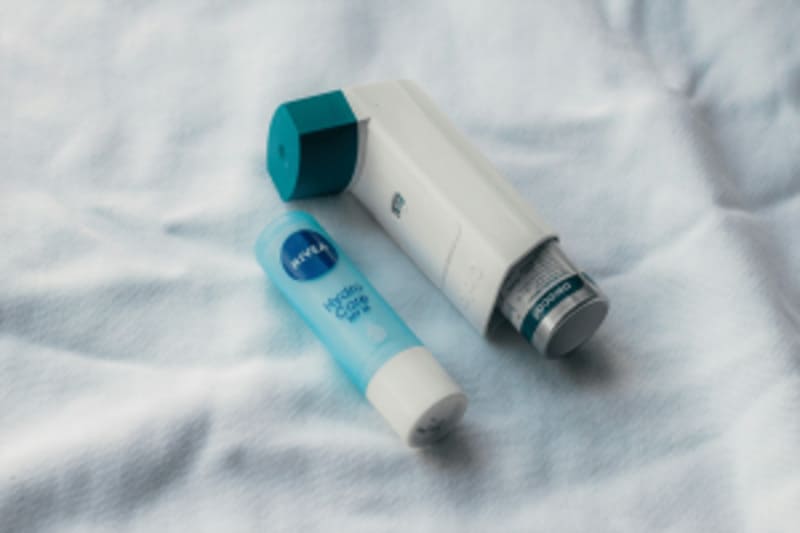Climate change continues to harm the environment and everyone who lives in it. Many things humans do contribute to the climate crisis: driving fossil fuel-powered cars, cutting down large sections of forests, emitting greenhouse gases as byproducts of farming and industrial production, and more.
Using certain types of inhalers can also contribute to climate change. Pressurized metered dose inhalers (pMDIs) in particular emit millions of tons of greenhouse gases every year, while dry powder inhalers (DPIs) don’t produce emissions anywhere near as high. How and why are DPIs better for the environment than pMDIs? This article will delve into the environmental impacts of both devices.
Why Are Metered Dose Inhalers Less Environmentally Friendly?
https://gty.im/2128593145
To use a metered dose device, a patient presses down on the top of the medication canister and the medication is propelled out of the canister and through its mouthpiece, and the patient breathes the medicine in as it’s puffed out. A pMDI propels the medication using hydrofluorocarbons, powerful greenhouse gases that contribute to global warming. Each puff from a pMDI releases a gas that’s 1,430 to 3,000 times more powerful than carbon dioxide in contributing to climate change.
To use a dry powder device, a patient breathes out, puts the mouthpiece up to their mouth, tightly seals their lips around the mouthpiece, and then deeply and quickly breathes in the medication. Since it’s activated by the patient’s breath, a DPI doesn’t use hydrofluorocarbon gas to propel the medication into the patient’s body; thus, it produces far fewer emissions per dose.
A pMDI releases around 500 grams of carbon dioxide (CO2) equivalent per dose. A DPI only releases around 20 grams of CO2 equivalent per dose, meaning its carbon footprint is around 95.8% lower than that of a pMDI. Writing in the Australian Journal of General Practice in 2022, Western Australian general practitioner Dr. Brett Montgomery and respiratory physician Dr. John Blakey explained that a person who switched from a pMDI to a DPI would reduce their carbon footprint by similar amounts as they would by switching from a gas-powered car to a hybrid car, or becoming a vegetarian.
The Environmental Impact of People Using pMDIs
Globally, using pMDIs produces around 0.03% of annual greenhouse emissions. In the United States, 75% of inhalers are metered dose ones; every year, these devices produce greenhouse gas emissions equivalent to driving 500,000 cars. In Australia, short-acting beta2-agonists (SABA) inhalers contribute the equivalent of 350,000 metric tons of carbon dioxide annually, while in the United Kingdom, metered dose ones produce the equivalent of nearly 1 million metric tons of carbon dioxide every year.
Like other greenhouse gases, the hydrofluorocarbons in pMDIs contribute to global climate change. Climate change has caused wildfire smoke and other air pollution to become more common and allergy seasons to last longer. These conditions are making it harder for people to breathe, increasing rates of respiratory diseases, and prompting more people to use these devices. It’s somewhat ironic how using pMDIs has contributed to this self-perpetuating cycle.
Should You Switch From Using a pMDI to a DPI?
Based on the evidence, switching from a pMDI to a DPI can benefit your health as well as the environment. A study published in the European Respiratory Journal in 2022 concluded that some patients in the UK who use DPIs have better asthma control than other patients who use pMDIs. Likewise, in Sweden, where less than 10% of inhalers prescribed and used are pMDIs, the rate of severe asthma is 2.5% lower than it is in either the UK (where 70% of inhalers are pMDIs) or the U.S. (where 75% are pMDIs).
After educating them about the environmental benefits of DPIs, doctors like Canadian family physician Dr. Samantha Green found that their patients have more readily adapted to using these devices. Their patients appreciated not only the devices’ health benefits but also their reduced carbon footprints, especially since climate change exacerbates respiratory problems. The UK’s National Institute of Health and Care Excellence (NICE) has also developed evidence-based decision aids to help patients and healthcare providers determine the most suitable devices for them.
Not every patient can or should switch from a pMDI to a DPI, though. While many adults can safely make the transition, children and elderly people who have limited lung capacity might be unable to generate enough force to use DPIs effectively; these patients might need to stick to using pMDIs. If you need to use a pMDI over a DPI, Dr. Montgomery says no one should make you feel guilty for doing so. You should always consult with your doctor if you’re wondering whether it’s worth it for you to switch from using a pMDI to a DPI.
What Are Pharmaceutical Companies and Governments Doing to Make DPIs More Available?
The UK’s National Health Service (NHS) has removed the two most carbon-intensive inhalers from formularies and designated DPIs as the default treatment for patients over the age of 11. Sweden has almost entirely replaced pMDIs with DPIs. Australia’s National Asthma Council (NAC) has encouraged general practitioners in the country to prescribe DPIs to patients whenever possible. The United States Food and Drug Administration (FDA) has spent $6 million on a study about the challenges of developing inhalers with smaller carbon footprints.
International pharmaceutical companies like GlaxoSmithKline and AstraZeneca have been working for years to develop new lower-emission propellants for their inhalers, and AstraZeneca has said they’re aiming to complete their propellant formula by next year. Some lung specialists and health policy researchers worry that these companies will dramatically raise prices for patients and payers since they can register updated inhalers as new products, although the U.S. Federal Trade Commission says that it’s been cracking down on these practices.
Final Thoughts
To combat the worst effects of climate change, we all must reduce our greenhouse gas emissions. Metered dose inhalers contribute to climate change due to the hydrofluorocarbons they use to dispense medicine; by doing so, they also indirectly increase the prevalence of respiratory diseases and the need for more inhalers.
Dry powder devices are more environmentally friendly since they don’t use hydrofluorocarbons; using DPIs can both reduce greenhouse gas emissions and improve asthma control. If you’re a patient who lives with a chronic lung disease or a healthcare provider who treats these patients, you should look into the medical and environmental benefits of DPIs.
Disclaimer: This article is intended simply to provide information. It does not replace the medical advice from a physician. Please speak with your doctor if you have any questions or concerns.
For More Great Content
Total Apex is an all-encompassing content producer. We provide heavily detailed articles every day on entertainment, gaming, sports, and so much more! Check out all our great sports content at Total Apex Sports. Check us out on X @TotalApexEandG and our other sites: Total Apex Sports Bets and Total Apex Fantasy Sports.









